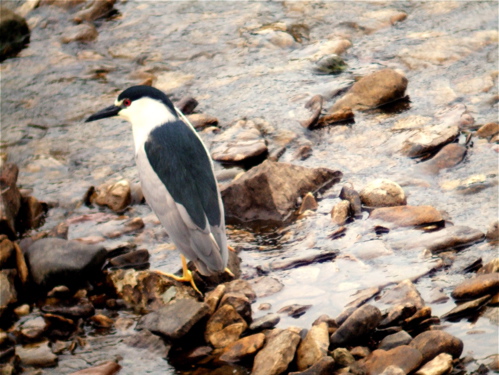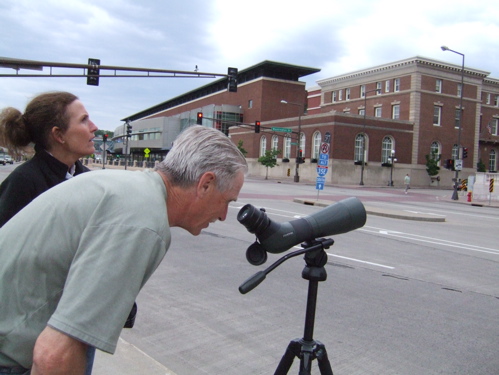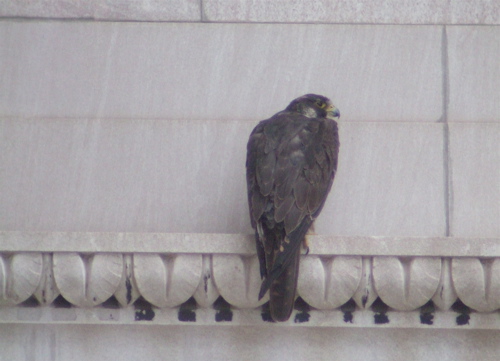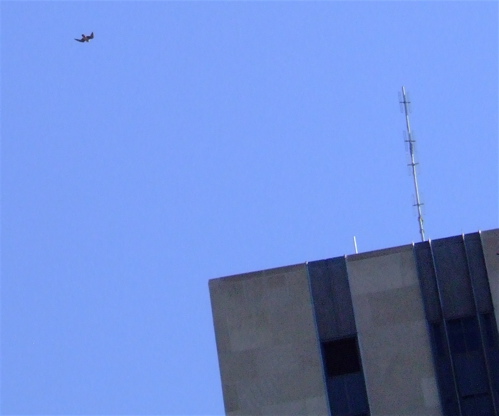 So, in April, I got a part-time job as a park ranger for the Mississippi River and it is a great time! I work primarily at the Mississippi River Visitor's Center at the Science Museum of Minnesota but I do get a chance to get out in the field. Last week, a group of staff went canoeing along the Vermillion Bottoms. What a joy to canoe in spring and get to know some of the people who work for the parks like the Historian, Botany Bob, and Rock Girl (nicknames all based on their areas of expertise--although Non Birding Bill said that we sounded like some sad band of super heroes: "The Historian and Birdchick canoe the river using their magical interpretation skills to save the people!")
So, in April, I got a part-time job as a park ranger for the Mississippi River and it is a great time! I work primarily at the Mississippi River Visitor's Center at the Science Museum of Minnesota but I do get a chance to get out in the field. Last week, a group of staff went canoeing along the Vermillion Bottoms. What a joy to canoe in spring and get to know some of the people who work for the parks like the Historian, Botany Bob, and Rock Girl (nicknames all based on their areas of expertise--although Non Birding Bill said that we sounded like some sad band of super heroes: "The Historian and Birdchick canoe the river using their magical interpretation skills to save the people!")
 I had a great time, the birding was fantastic. I couldn't really take my digiscoping equipment in the canoe, but still could watch the birds. Above, you might notice a bright yellow spot in that pile of brush--that was one of about eight prothonotary warblers we saw. You can't really tell it from the photo, but we could see them very well with the naked eyes. We heard parulas (and other warblers), had a flock of caspian terns fly over, saw one sandhilll crane, lots of eagles and I was totally surprised to see a flock of common nighthawks hawking for insects above our heads. I figured these normally nocturnal birds were mid-migration and very hungry.
I had a great time, the birding was fantastic. I couldn't really take my digiscoping equipment in the canoe, but still could watch the birds. Above, you might notice a bright yellow spot in that pile of brush--that was one of about eight prothonotary warblers we saw. You can't really tell it from the photo, but we could see them very well with the naked eyes. We heard parulas (and other warblers), had a flock of caspian terns fly over, saw one sandhilll crane, lots of eagles and I was totally surprised to see a flock of common nighthawks hawking for insects above our heads. I figured these normally nocturnal birds were mid-migration and very hungry.
 We stopped for bit and had lunch along the river. We were there at least thirty minutes and a few of us snuck off into the woods to...see a man about a horse. As I was working my way back, I heard a strange noise right about where the above photo was taken. I pished a few times and a few seconds later a HUGE turkey hen burst out of the grass...almost causing me to relieve myself on the spot. All of us should have noticed a turkey lurking in the grass during lunch...unless she was totally hunkered on a nest. I walked over to where she burst forth:
We stopped for bit and had lunch along the river. We were there at least thirty minutes and a few of us snuck off into the woods to...see a man about a horse. As I was working my way back, I heard a strange noise right about where the above photo was taken. I pished a few times and a few seconds later a HUGE turkey hen burst out of the grass...almost causing me to relieve myself on the spot. All of us should have noticed a turkey lurking in the grass during lunch...unless she was totally hunkered on a nest. I walked over to where she burst forth:
 There were the eggs. Poor thing must have been terrified when we pulled up our canoes and started eating. We had finished our lunch so we packed up as quick as we could and left to give her a chance to come back to her nest of fourteen eggs.
There were the eggs. Poor thing must have been terrified when we pulled up our canoes and started eating. We had finished our lunch so we packed up as quick as we could and left to give her a chance to come back to her nest of fourteen eggs.
 You do see quite a bit of litter along the river, one of the most disturbing piece we found was this two liter bottle of 7-Up filled to the brim with used hypodermic needles. EW!
You do see quite a bit of litter along the river, one of the most disturbing piece we found was this two liter bottle of 7-Up filled to the brim with used hypodermic needles. EW!
 Canoeing isn't the only thing I've been up to. The week before the canoeing, I got to go out and follow along with some of the eagle banding happening along the Mississippi River.
Canoeing isn't the only thing I've been up to. The week before the canoeing, I got to go out and follow along with some of the eagle banding happening along the Mississippi River.
 Even though the bald eagle is off the endangered species list, it's a good idea to keep tabs on them. Because they are so high on the food chain on the river, the researchers are using the eagles as an indicator species--if something is affecting them, it's eventually going to affect the humans. The birds all have a bit of blood drawn that's DNA tested and also checked for pollutants. Because the research is still going on, I can't give all the details at the moment...but it does make me want to be a bit more choosy about what part of the river I would eat fish from.
Even though the bald eagle is off the endangered species list, it's a good idea to keep tabs on them. Because they are so high on the food chain on the river, the researchers are using the eagles as an indicator species--if something is affecting them, it's eventually going to affect the humans. The birds all have a bit of blood drawn that's DNA tested and also checked for pollutants. Because the research is still going on, I can't give all the details at the moment...but it does make me want to be a bit more choosy about what part of the river I would eat fish from.
 Check out those eagle toes! I will say that it was fun to work with big birds in my banding comfort zone as opposed to those teeny warblers.
Check out those eagle toes! I will say that it was fun to work with big birds in my banding comfort zone as opposed to those teeny warblers.
 Professional tree climbers from out west were brought in to get the eagle chicks out of the nest. It was way cool to watch them work. They used a crossbow with an arrow and string attached. Once the arrow made it over an appropriate branch, a climbing rope was added and then the guys would climb the rope into the trees. It was impressive to say the least.
Professional tree climbers from out west were brought in to get the eagle chicks out of the nest. It was way cool to watch them work. They used a crossbow with an arrow and string attached. Once the arrow made it over an appropriate branch, a climbing rope was added and then the guys would climb the rope into the trees. It was impressive to say the least.
 It was interesting to notice the animals living the trees with the eagle nest. One tree had an oriole nest a few feet away. Above, a guy from the DNR was measuring the circumference of the nest tree when he shouted, "Hey, there's something nesting in here...and it's furry." He didn't want to stick his hand in, so I gave him my camera to stick in the hole and snap a photo:
It was interesting to notice the animals living the trees with the eagle nest. One tree had an oriole nest a few feet away. Above, a guy from the DNR was measuring the circumference of the nest tree when he shouted, "Hey, there's something nesting in here...and it's furry." He didn't want to stick his hand in, so I gave him my camera to stick in the hole and snap a photo:
 At first, we weren't sure what they were. I wondered if they were otter, but if you look at the back paws, that gives them away. Do you know? They're baby raccoons--prey, right in the base of a tree with an eagle nest!
At first, we weren't sure what they were. I wondered if they were otter, but if you look at the back paws, that gives them away. Do you know? They're baby raccoons--prey, right in the base of a tree with an eagle nest!
There have been requests to see the park ranger uniform:
 If you're thinking "Wow, a badge and a cool hat--that's gotta be fun!"
If you're thinking "Wow, a badge and a cool hat--that's gotta be fun!"
It is.
If you're at the Science Museum, stop in and say hello.
 We have a new activity we're offering this summer at the Mississippi National River and Recreation Area called Ranger River Walks. We meet at different parts of our park and show whoever is there around. There's an asterisk next to the list of parks that denotes if it's a specific birding ranger walk, but if I'm leading any of them, they will automatically be a birding walk, I can't help it. I did one yesterday at Lock and Dam 1 to see the peregrine nest box (above). Unfortunately, the nest failed, but the adults are still hanging out.
We have a new activity we're offering this summer at the Mississippi National River and Recreation Area called Ranger River Walks. We meet at different parts of our park and show whoever is there around. There's an asterisk next to the list of parks that denotes if it's a specific birding ranger walk, but if I'm leading any of them, they will automatically be a birding walk, I can't help it. I did one yesterday at Lock and Dam 1 to see the peregrine nest box (above). Unfortunately, the nest failed, but the adults are still hanging out.











